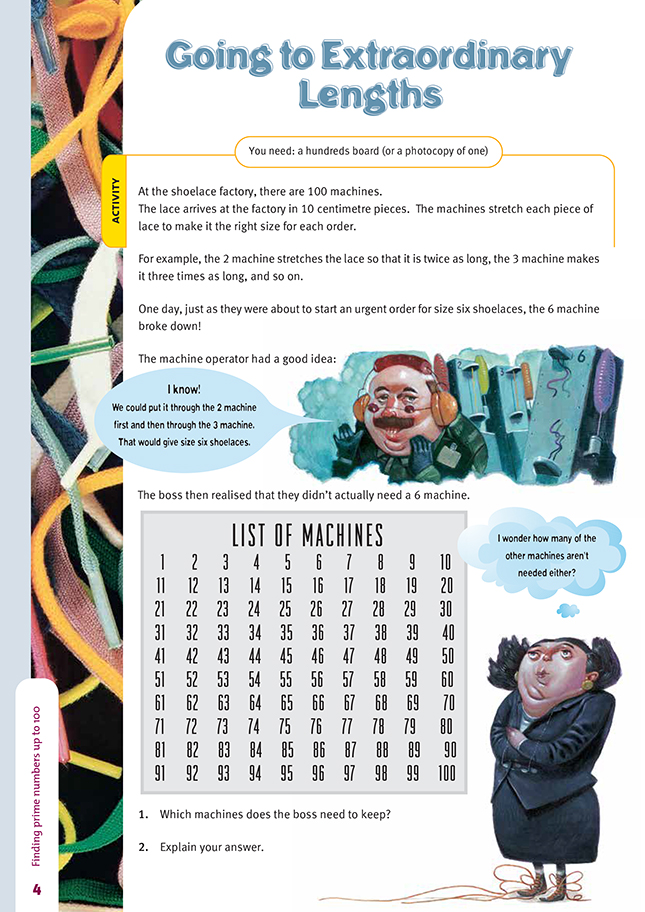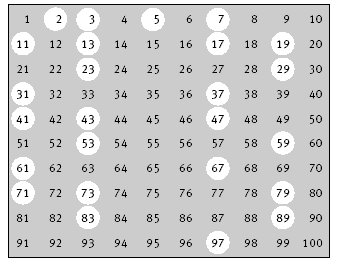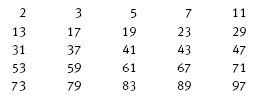This is a level 5 number link activity from the Figure It Out series. It relates to Stage 8 of the Number Framework.
A PDF of the student activity is included.
Click on the image to enlarge it. Click again to close. Download PDF (227 KB)
find prime numbers up to 100
Hundreds Board or a photocopy of one (Copymaster)
FIO, Link, Number, Book Four, Going to Extraordinary Lengths, page 4
This activity provides an unusual context for students to work with prime numbers and discover the power of prime factors.
Discuss what the machines do, perhaps using string or different-length laces to model the situation. You could simulate the process by stretching a rubber band. Ask: “What will the new lace look like when stretched through the 2 machine? … the 6 machine?” and so on. “How long would the lace be after going through a 10 machine? … a 15 machine?” and so on. (This is a good chance to practise mental multiplication strategies.)
When you are sure that the students understand the problem, it may be best to settle them into small groups to explore the problem and plan how they might work through their solution.
Some possible discussion points may include:
• discussing the statement that for any even number, at least one factor is 2.
• taking a general number like 24 and determining which factors can be used for a stretch of this length.
• discussing the statement that many of the numbers appear to be multiples of 2 and 3. (You could show this on a hundreds board.)
• looking at the different ways the prime numbers 2, 3, and 5 can be combined to get the same composites.
Encourage the students to keep a record of numbers that they can eliminate on their hundreds chart.
At the end of the session, discuss the students’ answers and compare the numbers that are left on everyone’s charts. Have the students share the different strategies they used to eliminate unnecessary machines.
A common way to sort through the prime numbers in 1 to 100 is to use a sieve approach (draining out the composite numbers and leaving the primes behind). Eratosthenes (275–194 BC) was a Greek mathematician who developed what has become known as the sieve of Eratosthenes.
The students can use Eratosthenes’ idea on a hundreds board, like this:
1. Cross off 1 because it’s not prime.
2. Leave 2 because it’s the smallest prime, but cross off every multiple of 2.
3. The number 3 is the next prime, so leave this too. Cross off all the multiples of 3. Some, like 6, may already be crossed off because they are also multiples of 2.
4. Leave 5, then cross off all its remaining multiples.
5. The only other number left in the first row will be 7, so cross off its multiples.
6. All the surviving numbers on the hundreds board are prime numbers. These are the machines that the boss needs to keep.
You can extend this problem by increasing the stretch up to 200 times. It should also be possible to look for other features of prime numbers on the hundreds board, such as finding twin primes (prime numbers that have a difference of 2). Ask your students:
“Is there a pattern of difference in the sequence of primes?”
“Are there more primes between 50 and 100 or between 100 and 200?”
“How far apart are prime numbers through the decades?”
Answers to Activity
1. The boss needs to keep these machines:
2. These machines have only two factors, themselves and 1. (These machine numbers are called prime numbers.) Therefore, shoelaces needing to be stretched by these scale factors cannot be made using any other machines.


